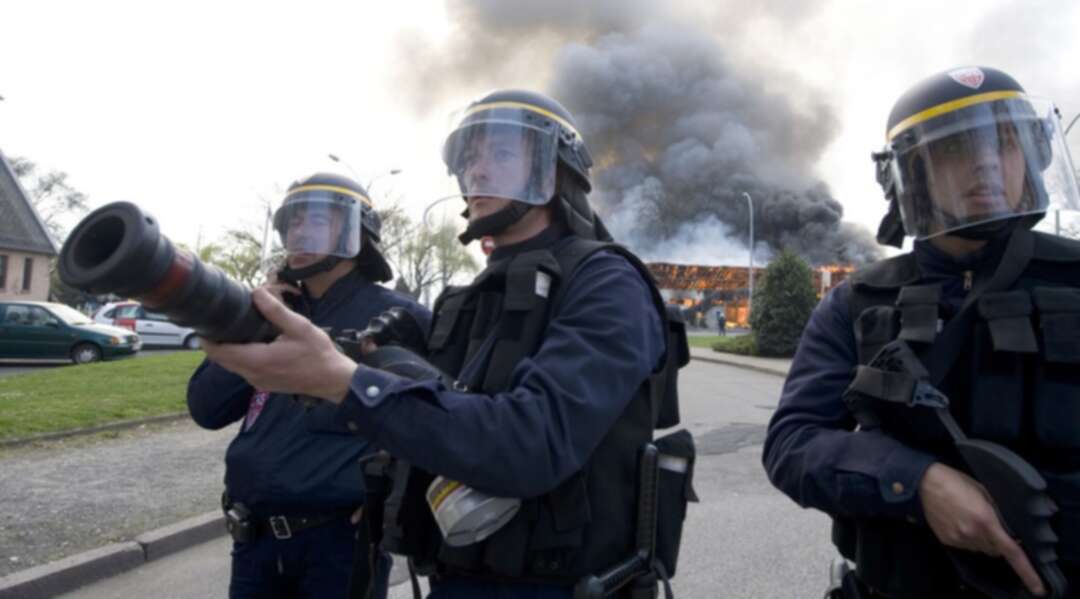-
Stock finally ran out? France ‘bans’ protester-maiming grenade not manufactured since 2014

France is finally joining the rest of Europe by withdrawing explosives from its arsenal of crowd control tools. The announced retirement of the protester-maiming GLI-F4 grenade, however, may be due to stocks running out.
The GLI-F4 is a controversial device that the French police and gendarmes consider a weapon of last resort before using live bullets. The 190-gram projectile, which can be thrown by hand or fired from a launcher, contains about 30 grams of the high explosive TNT. When it explodes, it produces a powerful blast, a deafening bang and a cloud of the tear gas CS.
https://twitter.com/lamor_rachid/status/1221423164762271749
The blast part is what poses the most danger because it can launch shrapnel and injure a person standing too close. Several protesters lost toes, fingers, and hands to these grenades while others suffered bone fractures, burns, and other serious traumas.
The policy rules are quite strict about how the GLI-F4 should be deployed: a supervisor has to assess the situation before ordering to fire, and the officer launching the grenade has to make sure it lands at a safe distance from the targeted people. In practice, in the chaotic environment of street protest rules are bent and people get hurt.
https://twitter.com/campaninimarco/status/1178011415103361028
So it's welcome news from Interior Minister Christophe Castaner, who announced on Sunday that the controversial weapon is finally getting retired. Except the 'ban' is probably more symbolic. The grenade retirement has been years in the making. The producer, Alsetex, stopped making them in 2014.
In May 2018 the French police announced the GLI-F4 was not on their procurement list for restocking grenades. They said at the time they will use up the remaining devices and switch to its intended replacement, the TNT-free GM2L. After Castaner's announcement, the newspaper Liberation asked the cabinet how many GLI-F4s remain in police stock, but did not get an answer. A police union secretary-general called the minister's announcement a PR stunt ahead of the municipal election.
A group of lawyers tried to have the GLI-F4 banned, but their motion was rejected by the Council of State in July 2019.
Ironically, the GLI-F4 was touted as a safer replacement for another Alsetex-made police explosive device, the OF-F1 grenade, which was suspended after one of them killed environment activist Rémi Fraisse during the October 2014 clashes at Sevens Dam.
Its replacement, the GM2L, has been rolled out since early 2018. Critics of French police tactics in dealing with protesters say the new grenade may still be too dangerous. But at least the French government will have less red tape to deal with — since it uses a pyrotechnic compound instead of high explosives, it's not considered a weapon of war and has fewer restrictions on packaging, transportation, and storage.
However, the absence of GLI-F4 in French streets does not mean participating in protests there becomes a safe endeavor. Other policy tools, like the golf ball-sized LBD 40 foam projectiles, have caused serious bodily harm to people.
source: Reuters
Tags
You May Also Like
Popular Posts
Caricature
BENEFIT Sponsors Gulf Uni...
- April 17, 2025
BENEFIT, the Kingdom’s innovator and leading company in Fintech and electronic financial transactions service, has announced its sponsorship of the “Innovation and Sustainable Technology Solutions Competition (GU - IST Solutions), hosted by Gulf University at its main campus.
This strategic sponsorship reflects BENEFIT’s active role in advancing technological innovation and fostering sustainable solutions to future challenges. It also seeks to empower Bahraini youth by enhancing their skills, capabilities, and competitiveness in innovation and solution development—contributing meaningfully to the broader goals of sustainable development across all sectors.
As part of BENEFIT’s active involvement in the competition, the company has announced that Hanan Abdulla Hasan, Senior Manager of Public Relations and Communication, will serve on the competition’s supervisory committee. Her upcoming participation reflects BENEFIT’s forward-looking commitment to championing academic and professional excellence.
Commenting on the occasion, Hanan Abdulla Hasan, Senior Manager of Public Relations and Communication at BENEFIT, said, “We are privileged to support this pioneering initiative, which aligns seamlessly with BENEFIT’s enduring commitment to fostering innovation and nurturing the potential of Bahrain’s youth. Our participation is rooted in a deep sense of social responsibility and a firm belief in the pivotal role of innovation in shaping a sustainable future. Through such platforms, we seek to empower the next generation with the knowledge, skills, and foresight required to develop impactful solutions that address future challenges, in line with the United Nations Sustainable Development Goals 2030.”
Dr. Aseel Al Ayash Dean of the College of Engineering in Gulf University commented, “We extend our sincere gratitude to BENEFIT for their generous sponsorship and support of the Innovation and Sustainable Technology Solutions Competition. This contribution plays an instrumental role in helping us achieve the strategic goals of this initiative, namely, cultivating a culture of innovation and sustainability, encouraging efforts that address the imperatives of sustainable development, and enhancing the practical and professional capabilities of our students and participants.”
The event will bring together a diverse spectrum of participants, including secondary school students, university undergraduates, engineers, industry professionals, entrepreneurs, academic researchers, and subject matter experts representing a wide range of disciplines.
The competition seeks to inspire participants to develop and present innovative, sustainable technologies aimed at addressing pressing environmental, social, and economic challenges. It encourages the formulation of business models that integrate advanced technological solutions with core principles of sustainability. Moreover, it serves as a platform for emerging leaders, entrepreneurs, and innovators to contribute to the advancement of the Sustainable Development Goals, promote the ethos of responsible technology, and demonstrate its transformative potential across various sectors.
Attendees will have the opportunity to view a series of project presentations submitted by participants, covering diverse areas such as eco-friendly product design, smart and sustainable innovations, renewable energy technologies, water conservation and management, waste minimisation and recycling, green architectural solutions, and sustainable transportation systems. Outstanding projects will be formally recognised and awarded at the conclusion of the event.
opinion
Report
ads
Newsletter
Subscribe to our mailing list to get the new updates!






















